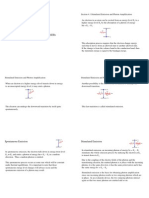14 1. Basic Physics of Lasers: Radiationless Transition
14 1. Basic Physics of Lasers: Radiationless Transition
Uploaded by
kunal3902323Copyright:
Available Formats
14 1. Basic Physics of Lasers: Radiationless Transition
14 1. Basic Physics of Lasers: Radiationless Transition
Uploaded by
kunal3902323Original Description:
Original Title
Copyright
Available Formats
Share this document
Did you find this document useful?
Is this content inappropriate?
Copyright:
Available Formats
14 1. Basic Physics of Lasers: Radiationless Transition
14 1. Basic Physics of Lasers: Radiationless Transition
Uploaded by
kunal3902323Copyright:
Available Formats
14
n1 E1 n2 Pumping
1.
Basic Physics of Lasers
Radiationless transition E2 Laser action E3
n0
E0
Radiationless transition
Fig. 1.9
Energy diagram of a four-level laser.
a small fraction of the Al3 ions are replaced with chromium Cr3 ions. The crystal is pumped by a flash lamp exciting the Cr3 ions from the ground electronic level E0 to the excited level E1, which is actually made up of sublevel series resulting from interaction between an electron and vibrations of the crystal lattice. The fast radiationless transition from the E1 state, characterized by a lifetime of about 50 ns causes the population of the metastable level E2 of the Cr3 ion, which has a lifetime of about 5 ms. If the flash lamp emits sufficiently intense pumping light, it is possible to produce population inversion that creates a laser action between the E2 and E0 levels (Fig. 1.8). The population inversion can be achieved either by increasing the metastable upper state population or by decreasing the lower state population. The latter cannot be used in the three-level lasers because the laser transition takes place between the metastable excited state E2 and the lowest energy level the ground state E0. It indicates that there is a competition between depletion and population of the E0 state, which leads to much lower efficiency of the population inversion than can be achieved in the four-level lasers illustrated in Fig. 1.9. In this case the level E3 populated as a result of the laser transition E2 ! E3 is depleted quickly in a radiationless transition E3 ! E0 . The four-level system permits a considerable increase in the efficiency of population inversion without delivering additional pumping energy. The most typical example of the four-level laser is a neodymium laser Nd:YAG (the solid active medium of the yttrium aluminum garnet (YAG) crystal doped with neodymium Nd3 ions) and a dye laser (liquid active medium). The ion argon Ar laser often used in molecular spectroscopy laboratories is not the four-level laser. However, it may be treated as a special case of the four-level laser, with a preliminary pumping causing the ionization of argon atoms (Fig. 1.10).
Radiationless transition Proper pumping 3p5 Radiationless transition Ionization pumping 3p6 Ar Ar+
4p Laser action 4s
Fig. 1.10
Energy diagram for one of the laser transitions of an argon laser Ar.
1.4.
Amplification and Saturation
15
1.4. AMPLIFICATION AND SATURATION In thermodynamic equilibrium the population of energy states is described by the Boltzmann distribution. This indicates that at any temperature the majority of molecules usually stays in lower energy states. This statement is not always true for rotational levels exhibiting a high degree of degeneracy. Since the probabilities of stimulated transitions from the lower energy state to the higher energy state (absorption) and from the higher energy state to the lower energy state (stimulated emission) are equal, the total number of upward transitions is larger than the number of downward transitions, and the system absorbs the radiation energy @! < 0; @t 1:26
where ! is the energy density of the external field, that is the energy per unit circular frequency from the range between ! and ! d ! in volume units. @ In order to amplify the incident radiation ( @t! > 0), the population inversion has to be achieved n m n > n ; gm g n 1:27
where nm and nn are the number of molecules at m and n energy levels, gm and gn are the degeneracy numbers of the energy levels. When the population inversion is achieved, the traditional Lambert-Beer equation I I0 e l loses its sense. It was derived for the assumption that the absorption coefficient is constant, which is valid only in linear optics, when the incident radiation intensity is small and deviation from thermodynamic equilibrium is negligible. When larger intensity radiation is employed more and more molecules become transferred to a higher energy level and the state of saturation is achieved n n m n : gm gn 1:28
This indicates that the system is bleached, neither absorption nor emission of energy dominates. The LambertBeer equation I I0 e l can be maintained formally if we assume that 0. With further growth of the incident radiation intensity the system achieves the state called the population inversion, that is n m > n n and the system begins gn gm to emit more energy than it absorbs (formally the absorption coefficient becomes negative < 0). Fig. 1.11 illustrates these three situations.
m Absorbing system n Transparent system
m Emitting system n
m n
>0
=0
<0
Fig. 1.11
Dependence of absorption coefficient on incident radiation intensity in nonlinear optics range.
You might also like
- Sample Deed of Sale of Motor VehicleDocument2 pagesSample Deed of Sale of Motor VehicleYsabelle65% (17)
- Visible Absorption Spectrum of IodineDocument10 pagesVisible Absorption Spectrum of IodinechristianNo ratings yet
- Raphex Answers 2010 PDFDocument15 pagesRaphex Answers 2010 PDFcarlosqueiroz7669100% (4)
- Arteriovenous Malformation (AVM) : Signs and SymptomsDocument7 pagesArteriovenous Malformation (AVM) : Signs and SymptomsCj UritaNo ratings yet
- Radial Wave Function and Angular Wave FunctionsDocument8 pagesRadial Wave Function and Angular Wave FunctionsBhavesh Garg100% (4)
- Unit 4 Laser PhysicsDocument47 pagesUnit 4 Laser PhysicsSiya JadhaoNo ratings yet
- Einsteins Coefficients-Ruby LaserDocument15 pagesEinsteins Coefficients-Ruby LaserthadiboinaNo ratings yet
- Optical SourcesDocument30 pagesOptical Sourcesomar.alamodiNo ratings yet
- Course Title: Laser Physics: Lecture # 3Document17 pagesCourse Title: Laser Physics: Lecture # 3FAKIHA GULZAR BS PhysicsNo ratings yet
- Laser and Fiber OpticsDocument64 pagesLaser and Fiber OpticsAk JaNo ratings yet
- Basics of Laser and Laser Light: L A S E RDocument42 pagesBasics of Laser and Laser Light: L A S E RShakir KhattakNo ratings yet
- LaserDocument27 pagesLaserSupu The clownNo ratings yet
- EDITED !!laser For Fall 2011-12Document7 pagesEDITED !!laser For Fall 2011-12Lone SparrowNo ratings yet
- Unit 4 Lasers: Properties of A Laser Beam 1. CoherenceDocument17 pagesUnit 4 Lasers: Properties of A Laser Beam 1. CoherenceMeghana Chowdary ArumilliNo ratings yet
- MODULE Three LMSDocument22 pagesMODULE Three LMSMamatha SreeNo ratings yet
- Module 8: Laser-IIDocument39 pagesModule 8: Laser-IIMuhammad OwaisNo ratings yet
- TRNT.: Le'AdsDocument1 pageTRNT.: Le'AdsNurul Fahmi AriefNo ratings yet
- Laser Principle: Eman Ali AteeqDocument40 pagesLaser Principle: Eman Ali Ateeqmairaj2No ratings yet
- Laser and MaserDocument10 pagesLaser and MaserDrAnkita V. KushwahaNo ratings yet
- IMPORTANTDocument4 pagesIMPORTANTAshrayKunnurNo ratings yet
- Laser System and Application: DirectionalityDocument19 pagesLaser System and Application: DirectionalityajityadavsNo ratings yet
- LaserDocument2 pagesLaserHafizSajidNo ratings yet
- Lasers and Fiber Optics-1Document45 pagesLasers and Fiber Optics-1bodavijayteja007No ratings yet
- Experiment No-1 Photoluminance (PL: ObjectiveDocument10 pagesExperiment No-1 Photoluminance (PL: ObjectivejawaidaligNo ratings yet
- LasersDocument24 pagesLasersWaseem AkramNo ratings yet
- Laser NotesDocument39 pagesLaser NotesAvinashNo ratings yet
- Applied OpticsDocument55 pagesApplied OpticsDevesh AgrawalNo ratings yet
- Principle of Spontaneous and Stimulated Emission - Einstein's Quantum Theory of RadiationDocument43 pagesPrinciple of Spontaneous and Stimulated Emission - Einstein's Quantum Theory of RadiationSksk SkskNo ratings yet
- Chapter 3 Gas Filled Detectors: 3.1. Ionization Chamber A. Ionization Process and Charge CollectionDocument16 pagesChapter 3 Gas Filled Detectors: 3.1. Ionization Chamber A. Ionization Process and Charge Collectionkostia1No ratings yet
- PDF 13jan24 0815 SplittedDocument4 pagesPDF 13jan24 0815 Splittedrokesh123ee3No ratings yet
- OFC - Lec - LASERDocument36 pagesOFC - Lec - LASERfatmagulkerim19No ratings yet
- Chapter 6 LASERDocument16 pagesChapter 6 LASERDhiraj chavanNo ratings yet
- LaserDocument15 pagesLaserkaran5singh-12100% (1)
- Engineering Physics: Einstein's Co-Efficient and 3-Level SystemDocument19 pagesEngineering Physics: Einstein's Co-Efficient and 3-Level SystemGaurav JainNo ratings yet
- Module 1 - LASERS - CSE - UPRDocument11 pagesModule 1 - LASERS - CSE - UPRcpanusha2116No ratings yet
- He-Ne LASER COMPONENTSDocument4 pagesHe-Ne LASER COMPONENTSAgnivesh SharmaNo ratings yet
- Lasers - An Engineering IntroductionDocument14 pagesLasers - An Engineering IntroductionBharath ManchikodiNo ratings yet
- Lasers: Spontaneous EmissionDocument10 pagesLasers: Spontaneous Emissionajay kumarNo ratings yet
- Raman Spectroscopy Basic Principle and TechniqueDocument9 pagesRaman Spectroscopy Basic Principle and TechniqueMohd Zulhairi Mohd NoorNo ratings yet
- STC 111 NotesDocument8 pagesSTC 111 Notesmaryedward6963No ratings yet
- Electronic StructureDocument26 pagesElectronic StructureDavidson ChanNo ratings yet
- LASERsDocument43 pagesLASERs23wh1a0525No ratings yet
- Raman Spectral NotesDocument4 pagesRaman Spectral NotesswethasNo ratings yet
- Photochemistry: Prof. M.N.R. Ashfold (S305)Document66 pagesPhotochemistry: Prof. M.N.R. Ashfold (S305)betjodaNo ratings yet
- Physics 244 Notes Lasers, Part 2: AmplificationDocument2 pagesPhysics 244 Notes Lasers, Part 2: AmplificationEryWiyadiNo ratings yet
- P - 3.12 - RM Kind of LasersDocument8 pagesP - 3.12 - RM Kind of Lasersdeekshithasweety0No ratings yet
- S. Kulin Et Al - Plasma Oscillations and Expansion of An Ultracold Neutral PlasmaDocument4 pagesS. Kulin Et Al - Plasma Oscillations and Expansion of An Ultracold Neutral PlasmaItama23No ratings yet
- Laser Theory and OperationDocument15 pagesLaser Theory and OperationChitrangi SharmaNo ratings yet
- Lasers: Characteristics of A LaserDocument9 pagesLasers: Characteristics of A Lasersreekrish108No ratings yet
- LASER 2 Optical Fibre MS 2024 Dec5Document74 pagesLASER 2 Optical Fibre MS 2024 Dec5agent47msrNo ratings yet
- Module 1 Notes 1chem Mescenotes - inDocument63 pagesModule 1 Notes 1chem Mescenotes - inHafizNo ratings yet
- Stimulated Emission Devices Lasers-P Rinciples and ApplicationsDocument27 pagesStimulated Emission Devices Lasers-P Rinciples and Applications鄧詔允No ratings yet
- T. C. Killian Et Al - Formation of Rydberg Atoms in An Expanding Ultracold Neutral PlasmaDocument4 pagesT. C. Killian Et Al - Formation of Rydberg Atoms in An Expanding Ultracold Neutral PlasmaItama23No ratings yet
- The Characteristics of Laser BeamDocument8 pagesThe Characteristics of Laser BeamSayyed SalmanNo ratings yet
- LaserDocument22 pagesLaserfaizNo ratings yet
- Quantum Mechanics and Laser TechnologyDocument31 pagesQuantum Mechanics and Laser TechnologyAlap PatelNo ratings yet
- Lect 1laserDocument9 pagesLect 1laserلينا اكرم صالحNo ratings yet
- Field Guide To LasersDocument11 pagesField Guide To LaserslantordoNo ratings yet
- Molecular Spectroscopy: Visible and Ultraviolet SpectrosDocument57 pagesMolecular Spectroscopy: Visible and Ultraviolet SpectrosDea JustinaNo ratings yet
- Intro Gas DetectorsDocument17 pagesIntro Gas DetectorsscdpintoNo ratings yet
- Micron, 27, 1996 - LvsemDocument17 pagesMicron, 27, 1996 - LvsemTao HasseNo ratings yet
- Mathematical Solution Unifying the Four Fundamental Forces in NatureFrom EverandMathematical Solution Unifying the Four Fundamental Forces in NatureNo ratings yet
- Sorry Is This Seat TakenDocument58 pagesSorry Is This Seat TakenArianne DiosoNo ratings yet
- Chattel Mortgage Jacquelyn AsaaliDocument3 pagesChattel Mortgage Jacquelyn AsaaliSRN Credit CollectionNo ratings yet
- GET - Basics - EngineeringDocument23 pagesGET - Basics - EngineeringAustin Mathew100% (1)
- Phonetics General Phonology:: Segmental Phonology: Supra-Segmental PhonologyDocument13 pagesPhonetics General Phonology:: Segmental Phonology: Supra-Segmental PhonologyMoahmmed AhmedNo ratings yet
- 70-698 Lesson07Document23 pages70-698 Lesson07Ramandeep kaurNo ratings yet
- Zotero User Guide PDFDocument16 pagesZotero User Guide PDFLjubisa MaticNo ratings yet
- Assessing The Knowledge, Attitude and Practices Among Health WorkersDocument36 pagesAssessing The Knowledge, Attitude and Practices Among Health WorkersSana EL FADELINo ratings yet
- Redox TitrationDocument10 pagesRedox TitrationJunior Singer DeepNo ratings yet
- Foundation DetailDocument1 pageFoundation DetailDEVCHADDHANo ratings yet
- Teacher ResumeDocument1 pageTeacher Resumeapi-531052254No ratings yet
- SSD - BCDocument14 pagesSSD - BCAndreea UniNo ratings yet
- Astm A 792Document6 pagesAstm A 792Mafer FbaNo ratings yet
- Introduction To IntegersDocument3 pagesIntroduction To IntegersVikrant DeshmukhNo ratings yet
- Version 3.1.5 (January 4, 2010)Document7 pagesVersion 3.1.5 (January 4, 2010)JesusLopezNo ratings yet
- The Effectiveness of Training Program in The Case of Ethio-TelecomDocument98 pagesThe Effectiveness of Training Program in The Case of Ethio-Telecomnati100% (1)
- New Trends in Human Capital Research and Analytics.Document9 pagesNew Trends in Human Capital Research and Analytics.Ashutosh100% (1)
- Reducing The Dangers of COVID-19 Through Shared Governance in A Philippine Jail - Current Issues in Criminal Justice - Vol 33, No 1Document4 pagesReducing The Dangers of COVID-19 Through Shared Governance in A Philippine Jail - Current Issues in Criminal Justice - Vol 33, No 1SEUNGWANderingNo ratings yet
- UWI Today 75th Anniversary of The UWI Digital Issue December 2023Document24 pagesUWI Today 75th Anniversary of The UWI Digital Issue December 2023Jacqueline Laguardia MartinezNo ratings yet
- A Short Essay PDFDocument4 pagesA Short Essay PDFSpirosKoutandosNo ratings yet
- Nông Thái Bảo - HE150030 2Document5 pagesNông Thái Bảo - HE150030 2Bao DucNo ratings yet
- Fujitsu ASYA12LGC Service InstructionDocument82 pagesFujitsu ASYA12LGC Service InstructionStein Hjalmar HansenNo ratings yet
- MBA 107 Business CommunicationDocument108 pagesMBA 107 Business CommunicationSherrin SebastianNo ratings yet
- When Technology and Humanity CrossDocument27 pagesWhen Technology and Humanity CrossHenniel Hael76% (29)
- Completion of The Centralized MRFDocument3 pagesCompletion of The Centralized MRFneil_potter16No ratings yet
- A Mathematical Perspective of Single-Channel Pseudo-Monopulse Tracking Receiver DesignDocument2 pagesA Mathematical Perspective of Single-Channel Pseudo-Monopulse Tracking Receiver DesignjiyamanNo ratings yet
- How To Make Chocolate From Scratch PDFDocument11 pagesHow To Make Chocolate From Scratch PDFZakiyah Kamto IrfinNo ratings yet
- Mushoku Tensei Volume 12 - Begaritto Continent ChapterDocument268 pagesMushoku Tensei Volume 12 - Begaritto Continent Chaptersonu shirpali100% (1)

























































































